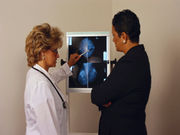More than one-third of women with metastatic breast cancer are extreme users
THURSDAY, May 12, 2016 (HealthDay News) — More than one in three women with metastatic breast cancer (MBC) are extreme users of disease-monitoring tests, with higher total health care costs seen in association with extreme use, according to a study published online May 9 in the Journal of Clinical Oncology.
Melissa K. Accordino, M.D., from the Columbia University Medical Center in New York City, and colleagues identified women with MBC diagnosed from 2002 to 2011 who underwent disease monitoring. The authors recorded the billing dates of serum tumor marker (STM) and imaging tests. Extreme use was defined as more than 12 STM and/or more than four radiographic imaging tests in a 12-month period.
The researchers identified 2,460 eligible patients, of whom 37.6 percent were extreme users of disease-monitoring tests. Hormone receptor-negative MBC, history of positron emission tomography scan, and more frequent oncology office visits were associated with extreme use (odds ratios, 1.63, 2.92, and 3.14, respectively). Extreme users had medical costs that were 59.2 percent higher per year. At the end of life, extreme users were more likely to use emergency department and hospice services.
“Despite an unknown clinical benefit, approximately one-third of elderly women with MBC were extreme users of disease-monitoring tests,” the authors write. “Efforts to understand the optimal frequency of monitoring are needed to inform clinical practice.”
One author disclosed financial ties to the pharmaceutical industry.
Copyright © 2016 HealthDay. All rights reserved.








